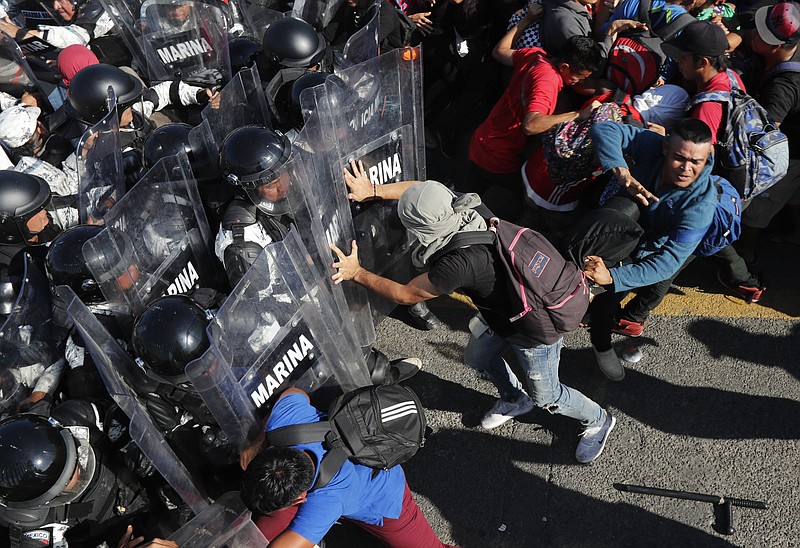TECUN UMAN, Guatemala (AP) — Mexican authorities closed a border entry point in southern Mexico on Saturday after thousands of Central American migrants tried to push their way across a bridge spanning the Suchiate River between Mexico and Guatemala.
Normally, migrants who want to request asylum in Mexico are allowed to cross the bridge. But many migrants prefer to pass through Mexico en route to the U.S., which has repeatedly asked Mexico to impede their arrival.
Speaking on condition of anonymity, a Mexican marine told the Associated Press on Friday his orders were to form a “human wall” to contain the flow of migrants. On Saturday, babies cried and tempers flared as hundreds of Mexican National Guardsmen blocked the path of thousands of migrants.
Mexico’s National Migration Institute said via Twitter on Saturday it had reinforced multiple points along the country’s southern border to assure “safe, orderly and regular immigration.”
As the crowd swelled on the bridge over the Suchiate, amid shoves, Mexican officials allowed several dozen migrants to enter the country in groups of 20, while a voice over a loudspeaker warned migrants against trying to slip into Mexico without passing through immigration filters.
Guatemalan authorities estimated 2,500 migrants were on the Suchiate bridge, or attempting to get onto it, on Saturday.
Nearby, hundreds of guardsmen lined the river to prevent migrants from crossing into Mexico clandestinely. The voice on the loudspeaker warned, over and over, those aiming to transit through the country may not be granted asylum in the U.S., even if they make it there.
Mexico’s government said migrants entering the country without registering will not be allowed to pass from its southern border area. But those seeking asylum or other protections will be allowed to apply and legalize their status in Mexico.
Guatemalan officials have counted roughly 3,000 migrants who registered at border crossings to enter that country in recent days and estimated there were an additional 1,300 migrants who did not register.
Vicente Hernández, head of the Mexican armed forces in the border area, told migrants on the Guatemalan side of the border “there are opportunities for everyone” in Mexico.
“Here you just have to register,” he added, saying Mexican officials would then offer the migrants jobs.
Mexico’s offer of legal status and potential employment for migrants carries a stipulation that would confine migrants to southern Mexico, where wages are lower and there are fewer jobs than elsewhere in the country.
A Mexican official who asked not to be named said those who request asylum in Mexico are brought to one of two migratory stations in the state of Chiapas — one in Tapachula and the other in Tuxtla Gutiérrez.
Once there, in theory, the migrants may request temporary work permits to remain in Mexico. For months, however, non-profit organizations and migrants have complained the migrants are instead often returned to their countries of origin.
Also, many of the migrants aim for a new life in the U.S. — not in Mexico.
“We are going to walk all the way up,” Salvadoran Jazmín González, 23, said while clutching a small girl.
González said she feared being deported as she turned herself over Saturday to Mexican authorities, alongside her daughter and three other family members.
Honduran Lourdes Geraldina Jiménez also decided to trust in the assurances of Mexican authorities as she entered Mexico with a son and another family member.
Jiménez said she left Honduras because gang members wanted to kill her 14-year-old son.
“I can’t return to Honduras,” she said, walking next to her son.
Many of the migrants leaving Central America said they fear for their lives back home, while others said they are looking for better economic prospects.

